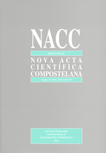Validation of lateral visibility of the ligament as a characteristic for fast discrimination between juveniles of Cerastoderma edule and C. glaucum (Mollusca, Bivalvia).
Contido principal do artigo
Resumo
Many different methods have been used to differentiate Cerastoderma edule (L., 1758) from C. glaucum (Bruguière,1789). However, very few of them are fast and valid for specimens less than 10 – 12 mm length. Although the lateral visibility of the ligament has been described as a discriminating trait, it is seldom used despite the fact that it can be applied immediately. To determine the validity of this characteristic at the juvenile stage, a group of specimens from both species was identified using both this and other methods based on the relationships between different valve sizes. In all of the specimens identified with these methods as C. glaucum, the ligament could not be detected in lateral view and vice versa, whereas the contrary is true for C. edule.
Palabras chave
Detalles do artigo
Citas
BOYDEN, C.R. & RUSSELL, P.J.C. (1972). The distribution and habitat range of the brackish water cockle (Cardium (Cerastoderma) glaucum) in the British Isles. Journal of Animal Ecology, 41(3): 719-734.
BROCK, V. (1978). Morphological and biochemical criteria for the separation of Cardium glaucum (Bruguière) from Cardium edule (L.). Ophelia, 17(2): 207-214.
DERBALI, A., ELHASNI, K., JARBOUI, O. & GHORBEL, M. (2012). Distribution, abundance and biological parameters of Cerastoderma glaucum (Mollusca: Bivalvia) along the Gabes coasts (Tunisia, Central Mediterranean). Acta Adriatica, 53(3): 363 – 374.
FOWLER, J. & COHEN, L. (1994). Practical statistics for field biology. Wiley, J. & Sons (eds.) 227 pp. Chichester.
FREIRE, R., INSUA, A. & MÉNDEZ, J. (2005). Cerastoderma glaucum 5S ribosomal DNA: characterization of the repeat unit, divergence with respect to Cerastoderma edule, and PCR-RFLPs for the identification of both cockles. Genome, 48: 427-442.
IGLESIAS, D., VILLALBA, A., NO, E., DARRIBA, S., MARIÑO, C., FERNÁNDEZ, J. & CARBALLAL, M.J. (2015). Cockle Cerastoderma edule marteiliosis first detected in Ría de Arousa (Galicia, NW Spain) has spread to other Galician rías causing mass mortality. 17th EAFP International conference on diseases of fish and shellfish. 1: 124.
KANDEEL, K.E., MOHAMMED, S.Z., MOSTAFA, A.F. & ABD-ALLA, M.E. (2013). Reproductive biology of the cockle Cerastoderma glaucum (Bivalvia:Cardiidae) from Lake Qarun, Egypt. Egyptian Journal of Aquatic Research, 39: 249–260.
LABOURG, P.J. & LASSERRE, G. (1980). Dynamique des populations de Cerastoderma glaucum dans une lagune aménagée de la région d’Arcachon. Marine Biology, 60: 147-157.
MACHADO, M.M. & COSTA, A.M. (1994). Enzymatic and morphological criteria for distinguishing between Cardium edule and C. glaucum of the Portuguese coast. Marine Biology, 120: 535-544.
MAGALHÃES, L., FREITAS, R. & DE MONTAUDOUIN, X. (2016). Cockle population dynamics: recruitment predicts adult biomass, not the inverse. Marine Biology, 163(16). DOI 10.1007/s00227-015-2809-3.
MALHAM, S.K., HUTCHINSON, T.H. & LONGSHAW, M. (2012). A review of the biology of European cockles (Cerastoderma spp.). Journal of the Marine Biological Association of the UK, 92(7), 1563–1577.
MARIANI, S., PICCARI, F. & DE MATTHAEIS, E. (2002). Shell morphology in Cerastoderma spp. (Bivalvia: Cardiidae) and its significance for adaptation to tidal and non-tidal coastal habitats. Journal of the Marine Biological Association of the UK, 82: 483-490.
OTERO LLOVO, J., DE COO MARTIN, A., GARCÍA FERNÁNDEZ, A., LÓPEZ GÓMEZ, M.C., GARRIDO MAURICIO, S. & LORENZO MIRANDA, J. (1984). Estudio biométrico de una población de Cerastoderma edule y Cerastoderma glaucum (Poiret, 1789) en la Ría de Arousa (Galicia). In Monteiro Marques, V. (Ed.) Proceedings of IV Simposio Iberico de Estudos do Benthos Marinho: 2: 307-314. Lisboa.
PARADA, J.M. & MOLARES, J. (2013). Artisanal exploitation of natural clam beds: Organization and Management Tools. In: da Costa, (Ed.), Clam Fisheries and Aquaculture: 11: 273 – 289. Nova Science Publishiers, Inc, Hauppauge NY.
POHLO, R.H. (1963). Notes on the discrimination between Cardium edule L. and Cardium lamarcki, Reeve (Lamellibranchia). Cahiers de Biologie Marine, 4: 177-182.
RYGG, B. (1970). Studies on Cerastoderma edule (L.) and Cerastoderma glaucum (Poiret). Sarsia, 43: 65-80.
TARNOWSKA, K., KRAKAU, M., JACOBSEN, S., WO1OWICZ, M., FÉRAL, J.-P. & CHENUIL, A. (2012). Comparative phylogeography of two sister (congeneric) species of cardiid bivalve: Strong influence of habitat, life history and post-glacial history. Estuarine, Coastal and Shelf Science, 107: 150-158.
VILLALBA, A., IGLESIAS, D., RAMILO, A., DARRIBA, S., PARADA, J.M., NO, E., ABOLLO, E., MOLARES, J. & CARBALLAL, M.J. (2014). Cockle Cerastoderma edule fishery collapse in the Ría de Arousa (Galicia, NW Spain) associated with the protistan parasite Marteilia cochillia. Diseases of Aquatic Organisms, 109: 55–80.
ZAR, J,H, (2010). Biostatistical analysis. 5ht Edition, Pearson International Edition, London, 960 pp.


